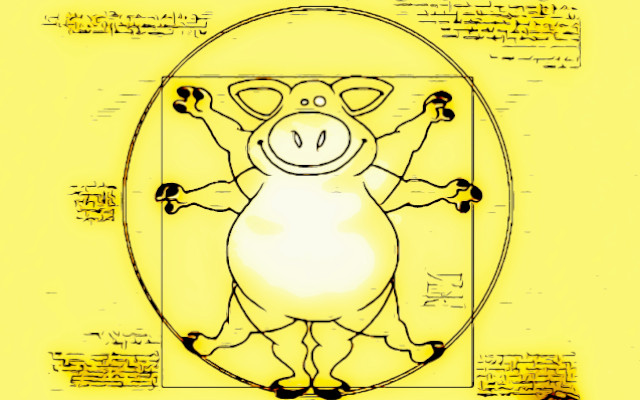Our investigation of the pig market continues with an analysis of carcass grading. A crucial passage, still plagued by serious anomalies.
‘Carcass classification’ allows the commercial value of slaughtered pigs to be estimated by analyzing the composition of each part of the animal. The procedure takes place in slaughterhouses and determines the price to be paid to the farmer.
In many countries, carcass grading is done by machines that provide objective data. In Italy, the affair is much more ‘creative’.
Pigs, transparency at the ford
Sharing the gross anomalies in the pig market in Italy-proposed by GIFT(Great Italian Food Trade) in previous articles (1,2)-has stimulated the initiation of a review of the system. The falsity of the data on the basis of which the single national price was being established by the CUN pigs, to the detriment of the breeders, (1) was shared by the Veneta Association of Breeders (AVA) with the MiPAAF, which finally took action to try to correct the anomalies.
The lack of reliable data on carcass classification, (2) which MiPAAF should update in a timely manner, thus stands out in its abnormality. After a 3-week blackout and reset, spurred by GIFT on 8.3.21, only 22 of 38 slaughterhouses reported classification data to the ministry. (3) And the latest Report provided to the CUN for the 11.3.21 meeting even removes any reference to the ministerial database.
Carcass classification, a crucial step
The importance of classification is glaring. It determines the value of the pig and especially its suitability for entry into the richer PDO production sector, where most of the pigs slaughtered in Italy converge.
In contrast, the residual share is left for the non-PDO market, which is subject to lower prices, from the price of the slaughtered animal to retail sale.
Classification of pigs, who decides
Carcass grading in many countries is now an automated procedure. The commercial evaluation of pork is entrusted to an apparatus (e.g., AutoFom, of Danish manufacture, the most widely used in Europe) that in a few moments provides objective and unchangeable data on the 4 major cuts (thighs, loins, shoulders, belly).
Automation of grading is the basis for transparency in negotiations, allows slaughterhouses to standardize supplies, and correctly remunerates farmers. Also teaching them what improvements to make in breeding. These are all advantages that the powerful German pig market, among the first to use automated grading, has benefited from for many years.
Italy, the ‘black box’ that is missing
The advantageous path of automated classification has also been chosen in Italy. Evidently without success. The case deserves a brief history:
8.7.2013. All industry representatives agree on a forward-looking ‘Pig Industry Supply Chain Understanding. Which, among other things, enunciates the decision to ‘work towards the introduction of additional mechanisms to ensure objectivity of judgment, such as the use of the ‘black box’ both in relation to classification and in relation to the acquisition of carcass weight.’ (4)
The agreement is signed by 5 regions, agricultural associations and organizations, Assica, Unapros, Parma and San Daniele protection consortia.
Black box, the start of the project with public funding
4.9.2013. In less than two months after the signing of the Understanding, the project to install a black box (technically ‘datalogger‘) in slaughterhouses comes to life. A circular from the two PDO certification institutes operating at the time (IPQ and INEQ) provides free installation of a first batch of equipment paid for by Mipaaf. (5)
9.1.2014. Months pass without any requests coming in. Thus, the Ministry of Agriculture issues Directorial Circular No. 175, where it is reminded that ‘to ensure the greatest possible transparency in grading and market price detection operations‘ and funds the purchase of an initial batch of dataloggers. He then urges slaughter facilities to install the new instrumentation with ‘due speed,’ anticipating the impending obligation expected from the revised DM 12.10.12. (6)
Back all
24.10.2018. The advance toward transparency in the pig market with the installation of black boxes in slaughterhouses is zeroed out by the government. The ministerial decree signed by Minister Gian Marco Centinaio cancels Circular 175/2014. (7)
What happened to the machines purchased by Mipaaf? How much did they cost us?
Three million in 2020
7.4.2020. The lesson was of no use to anyone. In the midst of the pandemic, 3 million euros are popping up among the ‘windfall’ of funding allocated to introduce the most advanced systems available for automated grading of pig carcasses in slaughterhouses.
The Ministry of Agriculture, then headed by Teresa Bellanova, puts on the plate ‘three million euros in the year 2020 for grants for the purchase and installation of Image-meater and AutoFOM automatic pig carcass evaluation machinery provided for in the “Commission Implementing Decision of January 24, 2014 on the authorization of methods for grading pig carcasses in Italy,” in order to enhance the value of domestic meat and ensure more objective transparency in value formation’.
Asked about the fate of those 3 million euros, Mipaaf does not provide answers.
Classification of pigs ‘Italian style’
Pending transparency, carcass grading in Italy is still performed in slaughterhouses without third-party, independent control. For carcasses destined for the PDO circuit, however, supervision by inspection bodies is provided.
In the beginning, the supervision of classifications was equally divided between the only two existing supervisory bodies. IPQ (Prosciutto di Parma PDO circuit) and IFCQ (Prosciutto di San Daniele PDO circuit), who were each conducting at least 8 visits per year on average in the largest slaughterhouses.
Beyond Trilussa’s average
With the closure of IPQ on Dec. 31, 19, the certification of products in the Parma PDO circuit was taken over by CSQA. Unlike its predecessor, however, the new certifier was not authorized to supervise the part of carcass classification previously covered by IPQ.
After all, according to the European Union, such activities must be awarded by contract. A procedure that, moreover, will soon be prepared, to regularize a practice that is ‘Italian-style’ as established as it is contrary to the dictate of European rules. And that it should identify bodies independent of all market interests.
Do-it-yourself vigilance?
The defect in CSQA commissioning may thus have left half of the pigs slaughtered in the past 14 months unchecked. The hypothesis has not been denied by Mipaaf or IFCQ, which we also questioned on this issue, while CSQA claims to be completely uninvolved and unaware of the facts.
If this were true, an unsound slaughter operator, in this environment lacking oversight and objective analysis of classifications, might be tempted to sell carcasses as suitable for PDO even when they are not. With the advantage of selling much more than it could, albeit at lower prices. Quantity rather than quality.
A downward game
In this downward game, Italian farmers have something to lose. Increased sales in the PDO channel would bring in more revenue in the immediate term. But the belief of breeding animals sought after in the PDO channel may be disillusioned when the supervision of classifications is entrusted to independent bodies, as required by EU rules.
Marta Strinati and Dario Dongo
Notes
1) Marta Strinati, Dario Dongo. Pig market, serious anomalies on prices set by CUN. GIFT(Great Italian Food Trade) https://www.greatitalianfoodtrade.it/mercati/mercato-suinicolo-gravi-anomalie-sui-prezzi-stabiliti-dalla-cun
(2) Dario Dongo, Marta Strinati. CUN pigs, the price is not (yet) right. GIFT(Great Italian Food Trade) https://www.greatitalianfoodtrade.it/mercati/cun-suini-il-prezzo-non-e-ancora-giusto/
3) See ‘week 9’ data at https://www.politicheagricole.it/flex/cm/pages/ServeBLOB.php/L/IT/IDPagina/16515
4) V. https://agricoltura. regione.emilia-romagna.it/comunicati-stampa/2013/luglio-2013/Intesasuini08072013firmatadoc.pdf
5) UNIFIED CIRCULAR 5 – ANNEX
6) MINISTERIAL CIRCULAR – ANNEX
7) V. , DM 24.10.18, Art. 27(C), Rules concerning the classification of beef and pork carcasses, price reporting and marketing of meat from cattle under 12 months of age . (18A08366) (OJ General Series No. 298, 24-12-2018) https://www.gazzettaufficiale.it/atto/serie_generale/caricaDettaglioAtto/originario?atto.dataPubblicazioneGazzetta=2018-12-24&atto.codiceRedazionale=18A08366&elenco30giorni=false
8) See Mipaaf Decree 7.4.2020 ‘Establishment of the National Pig Farming Fund‘. ANNEX





